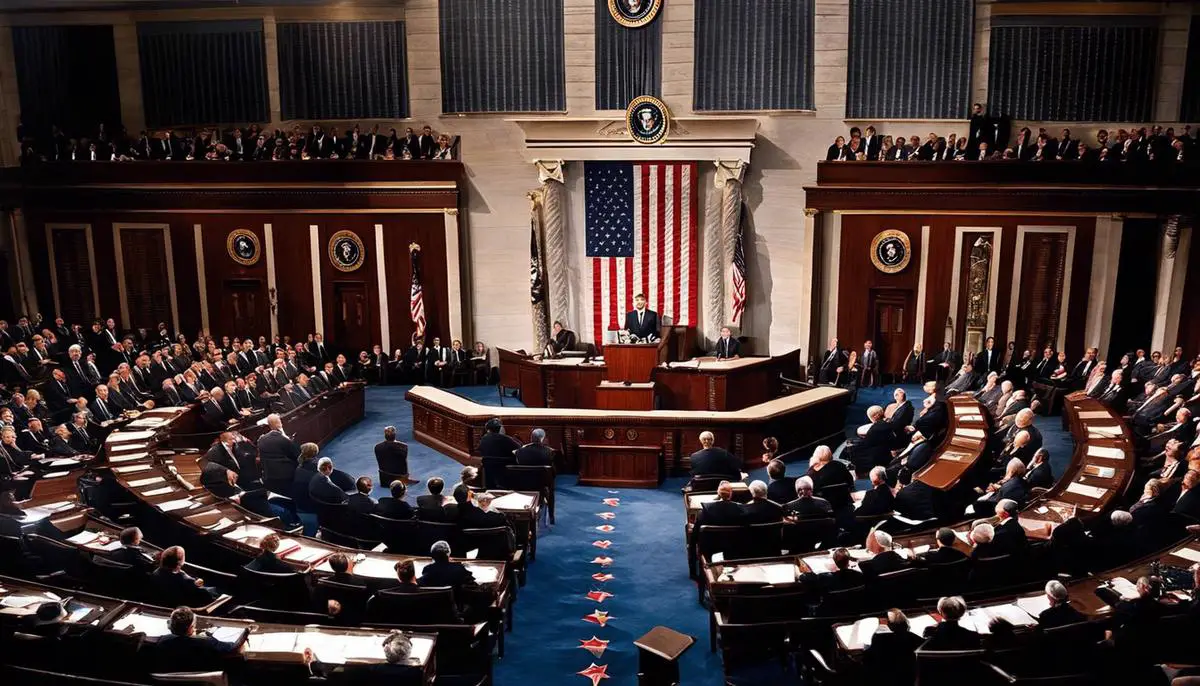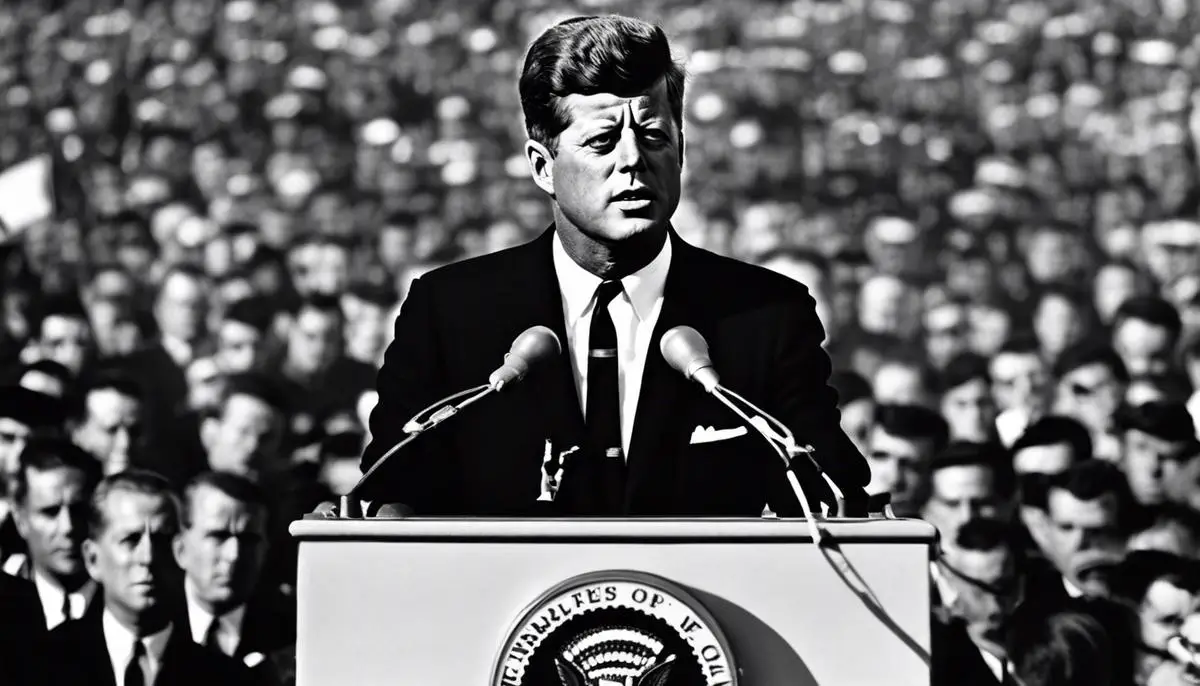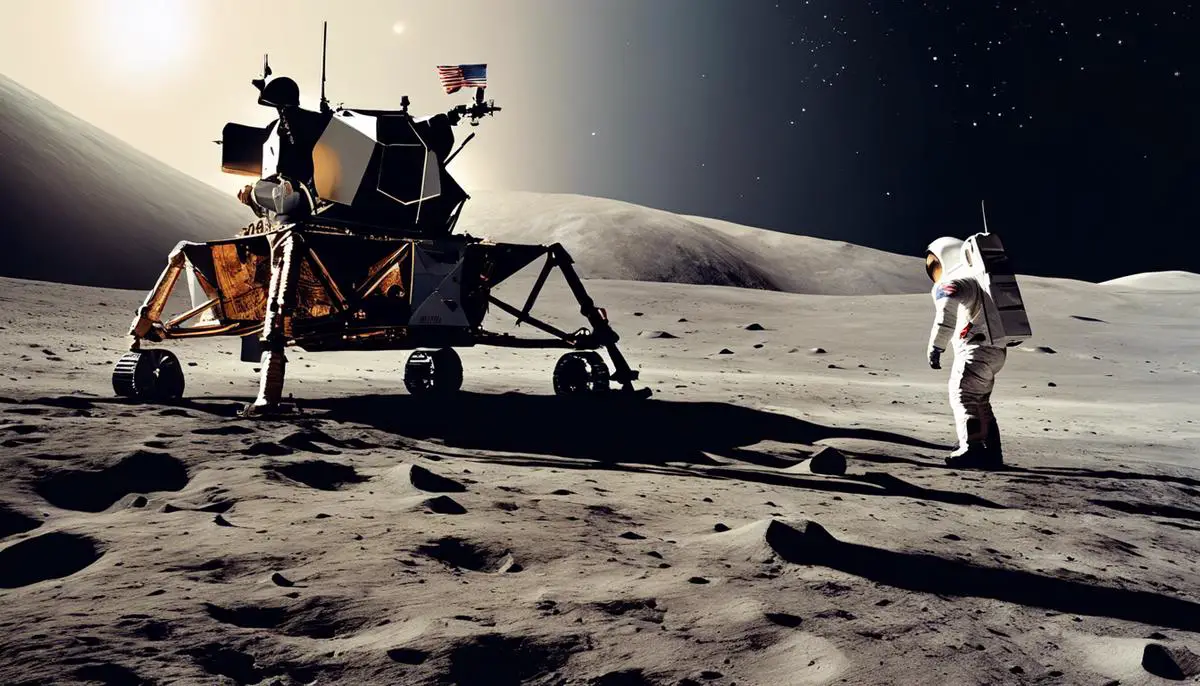At the dawn of the 1960s, the world stood at the precipice of a new frontier in human achievement and international competition. Amid the fervent heat of the Cold War, a young President, John F. Kennedy, rose to challenge not only the United States but the entire globe with a daring proposition—to place a man on the Moon and safely return him to Earth before the decade’s end. This extraordinary declaration breathed life into what would become the Apollo 11 mission, symbolizing the zenith of American ingenuity and resolve. Kennedy’s quintessential speech before Congress on May 25, 1961, not only sparked the ignition of the colossal effort against a backdrop of geopolitical rivalry but also marked the transition of space exploration from mere fantasy to tangible reality.
Contents
The Genesis of Apollo 11
The Scientific Zeal and Strategic Benevolence in Kennedy’s Apollo Mandate
Journal of Astronautics and Geopolitical Dynamics, Vol. XXIV
In exploring the impetuses behind the historic Apollo 11 mission, which culminated in humankind’s first steps on the lunar surface, it is crucial to understand the multifaceted motivations of President John F. Kennedy, a torchbearer of scientific ambition and geopolitical acumen. The undertaking of Apollo 11 was not solely driven by a quest for scientific enlightenment but equally by a clearly visualized geopolitical strategy, emblematic of the Cold War ardor reigning during its inception.
Kennedy’s tenure as president coincided with a time of formidable competition between the United States and the Soviet Union, not merely within the confines of terrestrial borders but extending into the very cosmos itself. It was in this climate of unequaled rivalry, following the Soviet’s inaugural human-crewed flight, that Kennedy envisaged the Moon landing as an endeavor of pivotal significance—a symbol of technological supremacy and an assertion of national prowess.
More than a mere reaction to Soviet cosmonaut Yuri Gagarin’s orbital flight, Kennedy’s Apollo vision was a calculated maneuver in the cosmic chess game of the Cold War. The mission personified the president’s foresight and resolve, seeking to amalgamate the nation’s scientific community toward a single, grandiloquent goal: securing a formidable American presence on the Moon.
Kennedy, with his perspicuous ardor for scientific progress, understood the potential for space exploration to usher in a new epoch of technological innovation and human knowledge. The lunar endeavor was to be not only a clarion call for American ingenuity but also evidence of an indomitable spirit willing to engage in peaceful competition via celestial vicinities. His inspirational address before a joint session of Congress on May 25, 1961, delineated this directive, framing it not as a whimsical journey but as a pivotal frontier, necessary for the advancement of the collective human condition.
“We choose to go to the Moon,” he declared, “not because it is easy, but because it is hard.”
President Kennedy catalyzed Apollo 11 from vision to reality through concerted efforts, galvanizing political will, authorizing substantial federal funding, and nurturing public enthusiasm. The vision was further concretized in a corollary address at Rice University, marking the earnestness of his resolve. Strategic decisions, such as the administration’s mobilization of NASA and the Defense Department, fostered an unparalleled coalition of industrial and academic expertise, constituting a national effort in pursuit of Apollo’s success.
Implicit within this Moonshot mandate was the understanding of the space race as a vector for not only prestige but also unprecedented collaborative scientific inquiry and technological development. Equipment and methodologies, evolved in response to Kennedy’s lunar aspiration, have furnished immeasurable contributions to fields far afield from astronautics alone—ushering in advancements in computer technology, telecommunications, and materials science, to name a few.
In sum, President Kennedy’s initiation of the Apollo 11 mission was a convergence of scientific curiosity, technological ambition, and geopolitical necessity. It was a testament to the power of visionary leadership to marshal a nation’s collective capabilities and transcend the bounds of Earthly limitation. Apollo 11’s resounding success in 1969, while posthumously honoring Kennedy’s dream, underscored the enduring impact of his forethought and strategic acuity in one of humanity’s most monumental achievements.
Undoubtedly, the enduring legacy of Apollo 11 is not only written in the annals of history books but ingrained in the foundational bedrock of contemporary space exploration, and a tribute to the transformative potential of human aspiration.

Presidential Leadership and Vision
President Kennedy’s Influence on Apollo Program Tempo and Trajectory
The focus of this discourse is the substantive effects of President Kennedy’s leadership style on the tempo and trajectory of the Apollo program. Recognizing the exigency imposed by the Soviet Union’s early successes in space, Kennedy’s administration instituted aggressive timelines that irrevocably accelerated the pace of the United States’ space efforts. This urgency translated into extensive financial support, with appropriations for NASA swelling from a fraction of a percent to more than 4 percent of the federal budget, an unprecedented allocation for a civilian agency.
The Kennedy administration’s penchant for setting audacious goals had a cascading impact on the organizational culture of the Apollo program. Kennedy’s directive to land a man on the Moon and return him safely to Earth by the end of the decade required the marshaling of vast and diverse resources, the rapid amelioration of technologies, and the cultivation of a resilient and innovative workforce. His hallmark commitment to public engagement and transparent communication fostered an environment where setbacks were met with resolve rather than deterrence, a vital component considering the tragedies and failures such as the Apollo 1 fire.
Kennedy’s judicious approach to international diplomacy influenced the Apollo program’s direction by presenting the moon landing as a peaceable quest for all mankind, while strategically countering Soviet propaganda. His invitation to share in the benefits derived from space exploration created a pathway for future international cooperation in space endeavors. This aspect of his leadership transformed the narrative of the Apollo program from one of insular national achievement to a platform for potential global unity.
Compelled as much by Kennedy’s charisma as by the political and social milieu, America’s industrial and technological sectors aligned with NASA’s mission. Corporations and academia synchronized efforts, fostering an interdisciplinary nexus that spurred innovations in materials science, computer technology, and many other fields. This synergy, initiated by Kennedy’s vision, was vital in overcoming the mammoth technical challenges posed by lunar exploration.
In sum, President Kennedy’s leadership engendered an organizational zeal that imbued NASA with a sense of purpose that transcended the geopolitical competition. By fostering a climate of exigency, promoting an inclusive narrative, and catalyzing technological and industrial partnership, Kennedy crucially shaped the Apollo program’s pace and trajectory. The resultant achievements not only realized the goal of Apollo but also laid the bedrock of modern scientific and exploratory endeavor in space.

Policy and Funding for Apollo
Given the exigencies posed by the Soviet Union’s triumphs in the early stages of the space race, President John F. Kennedy’s administration adopted a stance of resolute commitment to the Apollo program—a stance that was fundamentally transformative for the National Aeronautics and Space Administration (NASA). When President Kennedy audaciously declared the goal of landing a man on the Moon before the decade’s end, he set into motion an organizational culture within NASA that embraced challenge, innovation, and exceptionalism. This shift was as much about recalibrating mindsets within the space agency as it was about marshaling adequate resources to achieve lofty objectives.
Aggressive timelines set forth by the administration required vast appropriation of funds, which materialized through substantial budget allocations to NASA. In the fiscal years following Kennedy’s 1961 address to Congress, NASA’s budget increased multiple folds, peaking at approximately 4.41% of the total federal budget in 1966. The administration’s pledge to resource the venture saw groundbreaking investments in materials, technology development, human capital, and facilities expansion. The totality of these financial commitments catalyzed a chain reaction of advancements that were crucial for the success of the Apollo 11 mission.
Kennedy’s engagement with the public and commitment to transparent communication were pivotal in forging and maintaining popular support for the space endeavor. The administration’s savvy use of television broadcasts and media engagements allowed citizens to partake in the excitement of space exploration, transforming complex scientific endeavor into a public spectacle. This transparency nurtured an ethos of trust and enthusiasm that was instrumental during the politically turbulent 1960s.
Moreover, Kennedy’s judicious approach to international relations and diplomacy, characterized by a balance of assertive resolve and conciliatory outreach, had indirect yet substantial implications for the direction of the Apollo program. It prompted a narrative shift, tacit in its inception but resounding in its conclusion, from nationalistic triumph to a spirit of global cooperation symbolized by the “giant leap for mankind.” The mission, once emblematic of American prowess, became a testament to human collective achievement.
The Apollo mission imbued America’s industrial and technological sectors with a sense of purpose and urgency as the country’s manufacturing prowess and technological acumen were requisitioned in the service of NASA’s ends. The ecosystem of contractors and subcontractors that burgeoned in response to Apollo’s demands was a striking display of America’s capacity for industrial mobilization.
In navigating the formidable technical challenges of the Apollo program, an extraordinary level of interdisciplinary collaboration emerged. Astronauts, engineers, scientists, physicians, mathematicians, and a myriad of other specialists converged to address and solve issues as diverse as they were complex. This synergistic approach became a hallmark of the Apollo program, laying groundwork for future endeavors in similar high-stakes research and development environments.
President Kennedy’s visionary leadership indubitably shaped the pace and trajectory of America’s lunar aspirations. By fostering a climate of intellectual rigor, unyielding resolve, and intersectoral coordination, the Kennedy administration created the necessary policy and financial scaffolds that enabled the high-fidelity execution of the Apollo 11 mission. These actions and their rippling effects are reflected not merely in the historical accounts of the space race but tangible across the spectrum of modern scientific and exploratory pursuits. The Apollo program’s triumphs, innovations, and unquenchable curiosity endure as beacons of the enduring human spirit to explore, discover, and learn.

The Aftermath of Kennedy’s Commitment
The incorporation of ambitious timelines and the allocation of extensive financial resources were instrumental in driving the Apollo 11 mission to its successful culmination. The exigency imposed by the Soviet Union’s early forays into space, particularly the launch of Sputnik and the orbital flight of Yuri Gagarin, necessitated an aggressive response from the United States. The resulting pressure to achieve preeminence in space exploration catalyzed the establishment of demanding schedules that propelled NASA’s workforce to push the boundaries of technological feasibility and innovation.
The infusion of substantial funding into NASA, sanctioned by President Kennedy, underscored the nation’s resolve to not merely participate in the space race but to excel in it. This commitment fostered an environment of intense focus and dedication. Driven by the urgency to meet Kennedy’s mandate, NASA’s organizational culture was transformed, thereby cultivating an ethos where the formerly unthinkable – landing humans on the Moon – became a tangible objective.
The commitment to public engagement and the implementation of transparent communication emerged as cornerstones of the Apollo program. Public support was vital, and the meticulous chronicling and broadcasting of the Apollo missions through media outlets ensured that the American populace remained invested in this unprecedented endeavor, not only scientifically but also emotionally. This unyielding support further reinforced the perception that the lunar landing transcended mere national achievement, ushering in an era of global cooperation.
Moreover, Kennedy’s perspicacious approach to international relations extended to the domain of space diplomacy. The narrative of Apollo shifted, under his aegis, from an exhibition of unilateral triumph to one of collective human endeavor. The historic “We choose to go to the Moon” speech is emblematic of Kennedy’s charisma, coaxing the world to view the pursuit of space as a shared human quest rather than an insular national competition.
With the Apollo program’s trajectory irrevocably set, the industrial and technological sectors across the nation were synergized to meet the mission’s ambitious technological requirements. This alignment solicited a fusion of efforts from diverse sectors – including materials science, propulsion technology, and computer engineering, among others – integrating them towards the singular goal of successful lunar exploration.
This interdisciplinary collaboration, an epitome of problem-solving, was perhaps the most striking manifestation of Kennedy’s initial mandate. It was not simply the assemblage of a plethora of scientific minds but the harmonization of their collective genius that facilitated overcoming the myriad of technical challenges faced by the Apollo program. Each hurdle demanded innovative solutions, the legacies of which pervade contemporary aerospace engineering and related sciences.
President Kennedy’s leadership engendered a pace and trajectory for the Apollo program that has served as a model for subsequent exploratory missions. His foresight and determination to set the nation on a path to the Moon carved a legacy that persists within the annals of scientific discovery and exploratory ambition. The monumental achievements of the Apollo program continue to inspire current and future endeavors as humanity reaches further into the cosmos, undeterred by the vast unknowns.
Inextricably linked to the initial impetus provided by President Kennedy, the impact of the Apollo 11 mission reverberates through time. It served as a catalyst not only for the advancements in scientific knowledge and technological prowess but also as an enduring testament to the power of visionary leadership and the unrelenting human spirit in its quest to explore and understand the universe that it calls home.

As the lunar module ascended from the Moon’s desolate tranquility back to lunar orbit, rendezvousing with the command module Columbia, it did more than just carry the triumphant astronauts—it carried the fulfillment of a promise made by the late President Kennedy. The ripples of his lunar aspiration reverberated through the halls of history, as Apollo 11 crowned a momentous decade of technological triumphs and geopolitical shifts. The legacy of Kennedy’s boldness continues to resonate in today’s quests toward new horizons. Embedded in the very fabric of American culture and scientific pursuit, Kennedy’s vision forever altered our relationship with the cosmos, galvanizing an era of exploration that stretches ever outward, beyond the limits of our pale blue dot.
